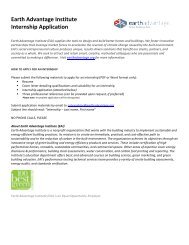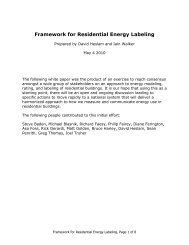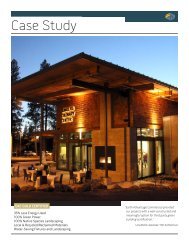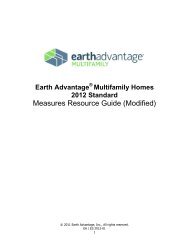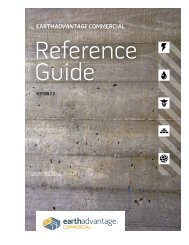EA New Homes Measures Guide - Earth Advantage
EA New Homes Measures Guide - Earth Advantage
EA New Homes Measures Guide - Earth Advantage
Create successful ePaper yourself
Turn your PDF publications into a flip-book with our unique Google optimized e-Paper software.
2012 <strong>Earth</strong> <strong>Advantage</strong> Residential<br />
<strong>Measures</strong> Resource <strong>Guide</strong><br />
5.1.1<br />
Premium Package - HRV/ERV system<br />
Energy<br />
Materials<br />
Water<br />
0 3 0 2 0<br />
Description: HRVs and ERVs must be installed according to manufacturer's installation instructions, including air flow balancing. They<br />
typically operate continuously on a low speed. Some have the ability to boost flow when more ventilation is needed. These may be used in<br />
place of local ventilation in bathrooms, provided they deliver enough ventilation at high speed to meet local ventilation requirements.<br />
Ideally, the duct system for HRVs and ERVs should be independent of a forced air heating system. However, they may be attached to a<br />
forced air heating system if the air handler has an electrically-commutated motor (ECM), also called a brushless DC motor, blower set to<br />
run at low speed during ventilation cycles. (Ventilation can occur during a heating or cooling cycle when the blower is operating at a higher<br />
speed.)<br />
Health<br />
Land<br />
Benefit: HRVs and ERVs are considered the premium ventilation systems. Using multiple points of exhaust and supply they provide<br />
superior means of air circulation and distribution. By tempering incoming air, these units provide greater comfort in extreme climates than<br />
other types of ventilation systems. They are highly effective and reduce the energy penalty associated with all fresh air ventilation. One<br />
drawback to fresh air ventilation is that fresh air pulled into the building must be heated or cooled to the comfort temperature. While this<br />
"energy penalty" is lower than the overall savings from air sealing, it is still a concern. Heat recovery ventilators (HRVs) address this issue by<br />
capturing from 50 percent to 90 percent of the heat from outgoing air and transferring it to the incoming air. Energy Recovery Ventilators<br />
(ERV's) take the idea one step further by recapturing the moisture from the outgoing air as well. This increases overall efficiency up to 85<br />
percent and can prevent excessive dryness that sometimes occurs. Ventilators with ECM motors have the added value of super-efficient,<br />
quiet operation. HRVs and ERVs are balanced ventilators in which the exhaust and supply air is roughly equal.<br />
Verification: <strong>EA</strong> Rater will record the brand and model of the HRV or ERV along with the rated air flow. Rater will verify the Supply air is<br />
routed from outdoor sidewalls, gable end wall, or soffit vent (with sealed ductwork to the exterior so no attic air can be drawn in.)<br />
5.1.2<br />
Supply Only - Forced air system<br />
Energy<br />
Materials<br />
Water<br />
0 2 0 1 0<br />
Description: Outdoor air is introduced into the return side of the forced air HVAC system. An electronically controlled adjustable mechanical<br />
damper must be used to control air flow to the air handler. The electronic control system must prioritize outdoor air delivery during normal<br />
heating and cooling cycles. Supply air must be routed from outdoor sidewalls, gable end wall, or soffit vent. The fresh air duct must be<br />
sealed with mastic paste. Avoid drawing supply air from the roof or any area that may generate harmful gasses or unpleasant odors.<br />
Install a controller that is capable of meeting the requirements of ASHRAE 62.2. A 24-hour clock timer is not allowed. The HVAC contractor<br />
must measure the flow of incoming fresh air to verify proper ventilation rate. The fresh air duct includes a manual or electronicallycontrolled<br />
adjustable damper set to an airflow rate meeting ASHRAE 62.2 2006 requirements. The damper must be adjusted to limit<br />
airflow to specified ventilation levels at the blower high speed setting.<br />
Health<br />
Land<br />
Benefit: This system can improve the indoor air quality of the house by mixing fresh air from outside. Because fresh air is introduced<br />
upstream of the typical air filter location, the incoming air can be filtered for pollen and dust that may be carried along with outdoor air.<br />
Existing ductwork distributes the fresh air throughout the building.<br />
Verification: <strong>EA</strong> Rater will engage the test mode to ensure that the furnace blower operates and the fresh air damper opens. The HVAC<br />
contractor will complete the Accountability Form attesting that they have designed the system to comply with ASHRAE 62.2 and measured<br />
the flow of the incoming fresh air to verify proper ventilation rate.<br />
Page 40 of 70



